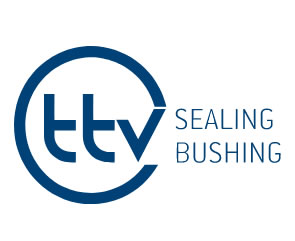
TTV GmbH +49 (0) 7303 - 92874 - 0 info@ttv-gmbh.de

Particularly in areas such as forestry, agriculture, mining, tunnelling, pellet production, material handling, construction and tracked vehicles, high demands must be met in terms of resistance to wear. The mechanical face seals also prove themselves under extreme conditions where effective protection against excessive wear is required.
While one half of the seal is fixed, the other half rotates on the mating surface with the housing. O-rings or special moulded rings made of nitrile butadiene rubber (NBR) or fluorocarbon rubber (FPM/FKM) are generally used for additional sealing. These elastic rings fix and position the metal glide rings in the housing.
Here you will find some important information on the different designs and their installation:
| Standard-Type | L-Type | X, Y-Type |
 |
 |
 |
The standard type of mechanical face seals consists of two identical metal sliding rings and two elastomer O-rings. These O-rings are fitted to the profile of the metal seal. At ttv, these seals are available in two material versions: alloyed cast iron and alloyed forged steel. The choice of O-ring material depends on the specific requirements of your application.
When installing the seal, the O-rings are pressed together between the conical contact surfaces of the sealing ring and the housing. The O-rings are subjected to a compression that is calculated according to ttv's standards and is around 25 per cent of the volumetric compression. This is crucial for the proper functioning of the sealing system.
The MRTZ type mechanical face seals, also known as L-type, consists of two metal rectangular sealing rings with identical geometric profiles. These sealing rings are mounted in the corresponding housing bores using trapezoidal rubber profiles. The geometry of the housing profile is comparatively easy to manufacture, and the installation of the seal requires only a simple assembly tool. Compared to mechanical seals of the ANTN type, the trapezoidal rubber ring is generally stiffer, which limits the permissible axial movement and tolerance.
Numerous mechanical face seals designs have been developed in the past to meet the diverse requirements. At ttv, we have some unique designs that are well suited for particularly demanding applications under difficult operating conditions.
In addition to our standard designs, we also offer the opportunity to work with your engineers to develop customised mechanical face seals. It doesn't matter if it's a new seal size, a new seal type or the use of new metal or elastomer materials. ttv's Engineering Solution Team has the necessary expertise to develop, produce, test and implement these concepts through to series production. We are ready to fulfil your individual requirements and develop customised solutions for your applications.
The alloyed cast iron sealing rings are preloaded with trapezoidal rings or O-rings. This achieves the good sealing function.
The relative movement in the circumferential direction only takes place between the sealing surfaces.
The static seal between each seal and the housing is ensured by an O-ring.
The sealing surfaces of the metal rings are hardened and precisely lapped. The elastomers are selected according to the application conditions.
The use of oil lubrication significantly increases the service life of the seal as it ensures better cooling. The selection is made taking into account the area of application, the available oil circuit arrangement in the system and the circumferential speed. As a rule, applications with higher speeds are suitable for oil lubrication. SAE 80 and SAE 90 gear oils are suitable for the typical operation of mechanical seals. After filling, the oil level should be approximately 2/3 of the available oil volume of the oil housing and above the seal axis. If filled correctly, the sliding surfaces are generally maintenance-free.
For applications with lower sliding speeds of up to approx. 1 m/s, grease lubrication is suitable as permanent lubrication of the sealing system. The gap in the sealing surface is an important design feature here. When filling with grease, it should be noted that increased grease pressure can cause the elastomer round cord rings to loosen from their position. Adequate lubrication of the sealing surfaces is crucial for the proper functioning of mechanical seals.
Our seals are suitable for harsh working environments and have been specially developed to withstand extreme conditions. Various technological developments are taken into account:
Our seals feature the most advanced and innovative corrosion-resistant surface treatments, including TSB (thermal protective coating), which effectively insulates high temperatures and improves heat dissipation.
For applications in extreme environments such as mining, dredging and rice cultivation, ttv has developed its own special cast iron materials that offer high abrasion and corrosion resistance and improve heat dissipation. Depending on customer requirements and applications, ttv offers various coating options to meet the demands of the harshest environmental conditions.
Whether agricultural machinery, construction machinery, forestry technology, drive technology, mechanical engineering, automotive or aerospace, we are ready for your challenges. With our engineering solutions, we manage to offer added value in all decisive product parameters through solutions developed specifically for customers and applications. Get to know our competence and best examples in the most diverse markets.